Games and the Metro Environment
Windows 8 can, of course, run traditional Windows games that run under the desktop and provide full‑screen experiences as well. The capabilities listed here are in addition to legacy features.
In Windows 7, Microsoft bundled several fun games that ran within the Windows desktop environment, as one might expect, as well as a container for games, if you will, called Games Explorer. This time around, Windows 8 instead integrates with Microsoft’s popular Xbox LIVE games and entertainment services. It includes a new app called Xbox Games, a central location for discovering, downloading, and buying new Xbox LIVE games for both Windows 8 and the Xbox 360. And of course, you can find and download more casual Metro‑style games through the Games area of Windows Store.
Note, however, that Windows RT cannot run traditional Windows games that run under the desktop.
The differences between Xbox LIVE games and other games can be important if you’re a bit more serious about gaming than the casual gamer. But we’ll discuss the vagaries of the Xbox LIVE service–and what it means to be an Xbox LIVE game title–later in the chapter. For now, let’s examine how Metro‑style games differ from their predecessors in earlier versions of Windows.
• Full‑screen, immersive experiences: Like all Metro‑style apps, Metro‑based games are full‑screen, immersive experiences. They provide a so‑called chrome‑free experience with no visible OS‑based user interface elements such as toolbars, window handles, and so on, and feature smooth, flicker‑free performance with adaptive layout capabilities that ensure that these games look great on any PC or device, regardless of the screen size or resolution.
Consider the game shown in Figure 10‑1. Here, you can see a game in which the entire screen is literally used for one purpose only: for the game itself. No other UI intrudes on this experience.
Figure 10‑1: Windows 8 Metro‑style games are full‑screen, immersive experiences.
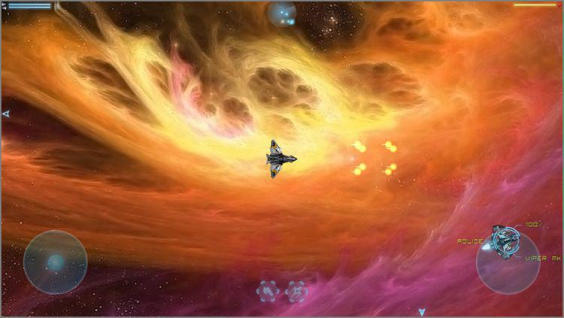
• Multi‑touch and sensor compatible: As with games on smartphones and other tablet‑based systems like the iPad, Windows 8 Metro‑style games integrate with underlying system capabilities such as multi‑touch and the gyroscope and other sensors and devices. This opens up a whole new realm of possibilities, such as driving games in which you physically move a tablet in space to steer, accelerate, and brake, or interactive games in which the device’s cameras are used to interact with the outside world.
On the flip side, these games are also generally designed to be used with other input devices. So if you’re using a mouse‑ and keyboard‑based PC instead of a tablet, you can still play.
• Integrated with Metro experiences: Like any other Metro‑style apps, Metro‑style games fully integrate with the wider Metro experiences. This means that edge and corner UIs such as the Charms bar, Back, Switcher, and Start are all available during gameplay. For example, in Figure 10‑2, you can see the Charms bar being displayed over a game.
Furthermore, you can receive notifications during gameplay. This can be helpful if you’re whittling away a few minutes before a meeting or other event, and you wish to be alerted when it’s time to get back to work. A typical notification, again being displayed over a game, can be seen in Figure 10‑3.
Figure 10‑2: Metro experiences such as the Charms bar are still available while playing a game.
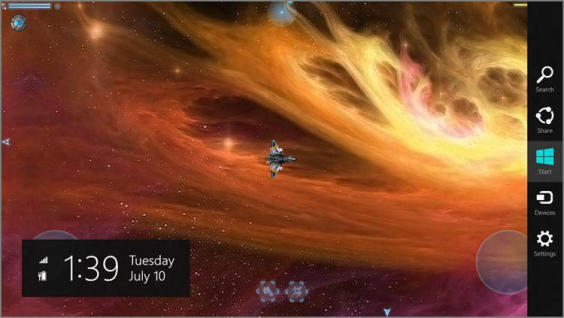
Figure 10‑3: Notifications still pop up onscreen during gameplay, too.
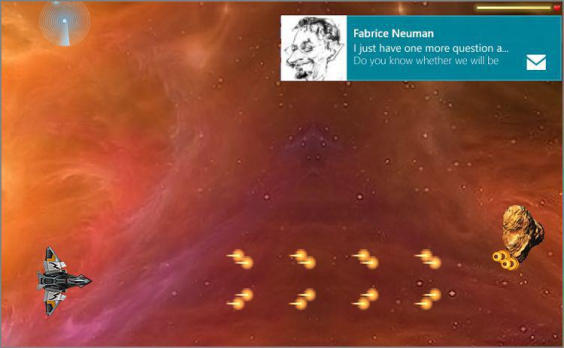
Metro‑style games also use the standard Metro‑style Settings interface, which is available via the Winkey + I keyboards shortcut or through Settings in the Charms bar. This consistency means that you will always know where to go to access game options, permissions and ratings capabilities, as shown in Figure 10‑4. That said, many games will opt to use their own interface for in‑game options.
Figure 10‑4: From Settings, you can access game permissions and ratings capabilities.
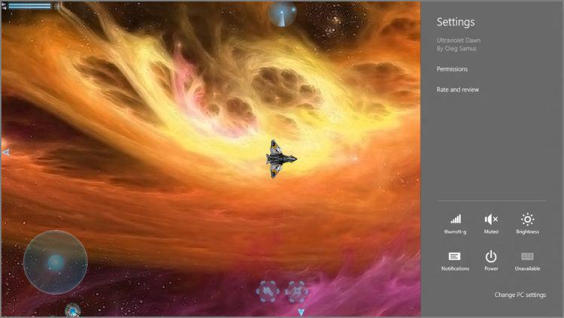
Finally, Metro‑style games can utilize any common Metro‑style user interfaces that are available to other apps, including edge‑triggered app bars, file pickers, and the like. (That said, many games will choose to use more customized experiences, but that’s up to the developer.)
You can find and acquire Xbox Games through the Xbox Games app, too, but it is utilizing Windows Store on the back end.
• Acquiring and updating happens through the Windows Store: Like other Metro‑style apps, Metro‑style games can only be acquired from Windows Store, and that includes free games, trial games, full games, and Xbox LIVE games. Ditto for software updates: When a game needs to be updated, you’ll see an alert badge on the Windows Store live tile on the Start screen and a notice about pending updates inside the Store app. No Metro‑style games can be offered elsewhere, for security and reliability reasons.
• Rights for up to five PCs and/or devices: One of the many upsides to Microsoft’s Windows Store requirements for Metro‑style games is that you have the right to install a purchased game on as many as five Windows 8 PCs and/or devices, each of which needs to be associated with your Microsoft account. This is in sharp contrast to retail video games, which are almost always licensed for use on just one PC.
• Compatible with both Intel‑compatible PCs and ARM‑based devices: Most Metro‑style games are designed to be compatible with both Intel‑compatible PCs as well as ARM‑based Windows RT devices. Not only that, but they are also engineered to perform similarly on both types of machines, regardless of the underlying architectural differences.
That said, you’ll want to be careful about choosing games that work on both, and as you can see in Figure 10‑5, the Windows Store landing page for each game will describe which platforms are supported.
Figure 10‑5: You can discover which platforms a game is compatible with in the Windows Store.
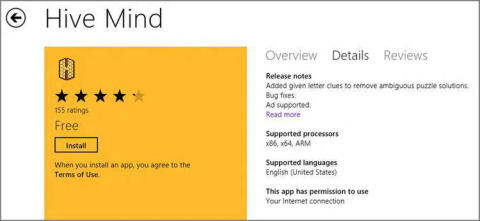
• In‑app purchases: Metro‑style games can provide in‑app purchases, which can include new content or functionality, such as unlocking the next level of a game, a new weapon, or other trinket. In‑app purchases have proven to be very popular on other casual game platforms like smartphones and, no doubt, will prove to be so in Windows 8 as well.
• Not just for simple games: While there is no shortage of simple, casual games like Checkers and Hangman, Windows 8 Metro‑style games can be as photo realistic and exciting as anything on the Xbox 360 or other dedicated game platforms. The system supports advanced DirectX capabilities for both 2‑D and 3‑D experiences that take advantage of every ounce of processing muscle your PC can provide. Will there be a future version of Call of Duty or Halo in a Metro‑style version? There’s no (technical) reason why not.
• Multiplayer online games: You’re not (necessarily) alone when you game on Windows 8. Metro‑style games can support full multiplayer capabilities as well, letting you compete with others online in real time.
• Optional integration with Xbox LIVE: As noted earlier and described later in the chapter, developers can choose to release their games as is or integrate them into the Xbox LIVE service. This requires additional work on their part, but Xbox LIVE also provides additional capabilities as you’ll soon discover. Xbox LIVE games are also available separately through the Xbox Games app.
Дата добавления: 2015-05-13; просмотров: 1176;
